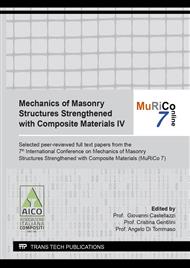[1]
X. Wang, B. Ghiassi, D. V. Oliveira, C.C. Lam, Modelling the nonlinear behaviour of masonry walls strengthened with textile reinforced mortars, Eng. Struct. 134 (2017) 11–24. https://doi.org/10.1016/j.engstruct.2016.12.029.
DOI: 10.1016/j.engstruct.2016.12.029
Google Scholar
[2]
X. Wang, C.C. Lam, V.P. Iu, Bond behaviour of steel-TRM composites for strengthening masonry elements: Experimental testing and numerical modelling, Constr. Build. Mater. 253 (2020) 119157. https://doi.org/10.1016/j.conbuildmat.2020.119157.
DOI: 10.1016/j.conbuildmat.2020.119157
Google Scholar
[3]
T. D'Antino, L.H. Sneed, C. Carloni, C. Pellegrino, Influence of the substrate characteristics on the bond behavior of PBO FRCM-concrete joints, Constr. Build. Mater. (2015). https://doi.org/10.1016/j.conbuildmat.2015.10.045.
DOI: 10.1016/j.conbuildmat.2015.10.045
Google Scholar
[4]
A. Dalalbashi, B. Ghiassi, D. V. Oliveira, A. Freitas, Effect of test setup on the fiber-to-mortar pull-out response in TRM composites: Experimental and analytical modeling, Compos. Part B Eng. 143 (2018) 250–268. https://doi.org/10.1016/j.compositesb.2018.02.010.
DOI: 10.1016/j.compositesb.2018.02.010
Google Scholar
[5]
B. Ghiassi, D. V Oliveira, V. Marques, E. Soares, H. Maljaee, Multi-level characterization of steel reinforced mortars for strengthening of masonry structures, Mater. Des. 110 (2016) 903–913. https://doi.org/10.1016/j.matdes.2016.08.034.
DOI: 10.1016/j.matdes.2016.08.034
Google Scholar
[6]
X. Wang, C.C. Lam, V.P. Iu, Comparison of different types of TRM composites for strengthening masonry panels, Constr. Build. Mater. 219 (2019) 184–194. https://doi.org/10.1016/j.conbuildmat.2019.05.179.
DOI: 10.1016/j.conbuildmat.2019.05.179
Google Scholar
[7]
D. V. Oliveira, I. Basilio, P.B. Lourenço, Experimental Bond Behavior of FRP Sheets Glued on Brick Masonry, J. Compos. Constr. (2010). https://doi.org/10.1061/(asce)cc.1943-5614.0000147.
DOI: 10.1061/(asce)cc.1943-5614.0000147
Google Scholar
[8]
M.O. R., A.R. A., Evaluation of pull-off tests as a FRP-concrete bond testing method in the laboratory and field, Pract. Period. Struct. Des. Constr. 19 (2014) 4014001. https://doi.org/10.1061/(ASCE)SC.1943-5576.0000170.
DOI: 10.1061/(asce)sc.1943-5576.0000170
Google Scholar
[9]
ASTM C1583-2013, Standard test method for tensile strength of concrete surfaces and the bond strength or tensile strength of concrete repair and overlay materials by direct tension (pull-off method), (2013).
DOI: 10.1520/c1583_c1583m-20
Google Scholar
[10]
T. Ueda, J. Dai, Interface bond between FRP sheets and concrete substrates: properties, numerical modeling and roles in member behaviour, Prog. Struct. Eng. Mater. 7 (2005) 27–43. https://doi.org/https://doi.org/10.1002/pse.187.
DOI: 10.1002/pse.187
Google Scholar
[11]
Z.J. Yang, X.T. Su, J.F. Chen, G.H. Liu, Monte Carlo simulation of complex cohesive fracture in random heterogeneous quasi-brittle materials, Int. J. Solids Struct. 46 (2009) 3222–3234. https://doi.org/https://doi.org/10.1016/j.ijsolstr.2009.04.013.
DOI: 10.1016/j.ijsolstr.2009.04.013
Google Scholar
[12]
B. Pulatsu, E. Erdogmus, P.B. Lourenço, J. V Lemos, K. Tuncay, Numerical modeling of the tension stiffening in reinforced concrete members via discontinuum models, Comput. Part. Mech. 8 (2021) 423–436. https://doi.org/10.1007/s40571-020-00342-5.
DOI: 10.1007/s40571-020-00342-5
Google Scholar


